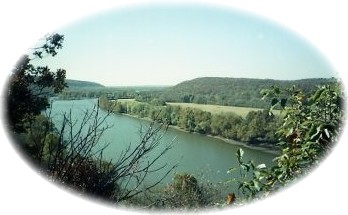Cherokee County, OK
 This area is inseparably linked with the history of the Cherokee. Before 1800 the area was the ancestral home and territorial hunting domain of first the Caddo and then the Osage Indians. Most Indian artifacts found will be of these tribes.
This area is inseparably linked with the history of the Cherokee. Before 1800 the area was the ancestral home and territorial hunting domain of first the Caddo and then the Osage Indians. Most Indian artifacts found will be of these tribes.About 1800 an Indian trader named Lovely made a purchase agreement with the Osage for a 100 mile square of land which became known as "Lovely's Purchase." He built a courthouse which was the seat of government affairs. It was located at a site first known as "Kidron" and later, after the Cherokees arrived, as Dwight Mission. Dwight Mission is fifteen miles east of Gore and north of Highway 64. The first known white man to bring his family and settle here was Captain mark Bean in 1803. He built a farm on the bank of the Illinois River encompassing the area of the Lake Tenkiller Dam.
The Treaty of 1817, between the U.S. Government and a portion of the Cherokee Nation, started the Cherokee migration to this area. This Western nation and Chief John Jolly established a settlement and capitol called Tahlanteeskee with a National Council House and Courthouse on the Illinois River just east of Gore. The Cherokee Nation maintains this historical site for visitors.
When the Eastern Cherokee Nation was driven from their homeland on the "Trail of Tears" in 1838-1839 the two nations were reunited and the capitol was reestblished at Tahlequah. Captain Mark Bean and numerous other white pioneer settlers were forced to move from this area by the U.S. Government in 1829 because the land was decreed "Cherokee Land."
A member of the Western Cherokee Nation by the name of George Gist (Sequoyah) developed the Cherokee alphabet (syllabary) about 1820 so the tribe could better communicate in their language on paper. He became a noted leader in the Cherokee Nation. His historical home site and Memorial is located a few miles north of Sallisaw.
The Cherokee Nation, now a model of the result of creating success from hardship, has maintained several historical sites which have developed since its arrival in Oklahoma. In and near Capitol Building, the old Tribal Prison, Cherokee Supreme Court Building, Female Seminary built in 1889, an historic Indian Village, Museum, and the famous outdoor at Tsa-La-Gi. South of Tahlequah, the W.W. Keeler Cherokee Nation Tribal Complex has provided administrative and legislative offices for the Cherokee Nation since 1979. Today, the Cherokee Nation boasts a membership of more than 160,00 with an annual budget in excess of $86 million.
Explore Cherokee County
Cherokee Supreme Court Building
This structure was built in 1845 by James S. Pierce to house the Cherokee National Supreme Court. The supreme and district court both held sessions here for some time. The "Cherokee Advocate" was also printed in this building for several years after the original Advocate building burned. About 1875
Tahlequah, OK Ethnic HeritageThe First Telephone
Here in September, 1885, the first telephone in Oklahoma was connected for service. It was the first telephone in the Mississippi Valley west of St. Louis. The company was organized by a group of Cherokees, namely, D.W. Lipe, L.B. Bell, R.M. Wolfe, J.S. Stapler, J.B. Stapler, and E.D. Hicks.
Tahlequah, OK Markers
Memorial to the Confederate Dead
Erected in 1913 by the Colonial William Penn Adair Chapter of the Daughters of the Confederacy.
Tahlequah, OK MemorialsTsa-La-Gi Outdoor Theater
Also located on the grounds of the Cherokee Heritage Center is the Tsa-La-Gi Theater, a 1,200
Tahlequah, OK TheatresSelf-Guided Tour of Historic Tahlequah
History is one of Tahlequah's most valuable resources, much of it in the history of the Cherokee Nation ... to a Civil War cabin ... to homes of townspeople at the turn of the century.
Tahlequah, OK ToursAdams Corner Rural Village
Adams Corner Rural Village is a detailed reconstruction of a small crossroads community of 1875 - 1890, in the final years of the old Cherokee Nation. The Heritage Farm exhibits livestock commonly found on Cherokee farms along with endangered domestic breeds.
Tahlequah, OK MuseumsMonument to John Ross
John Ross 1790-1866
Principal Chief of the Cherokee, 1828 - 1866
Born October 3, 1790 in Turkeytown, Alabama, the son of a one-quarter Cherokee maiden and a Scotsman, John Ross was elected as the first Principal Chief of the Cherokee Indians in 1828
Tahlequah, OK MonumentsCherokee National Prison
This sandstone building was erected in 1874 and originally had three stories. The third story was removed in 1925
Tahlequah, OK Historic BuildingsMurrell Home
The Murrell Home was built in the new Cherokee Nation about 1845 by George M. Murrell. Murrell was a native Virginain who married Minerva Ross in 1834. Minerva was a member of a wealthy mixed-blood Cherokee/Scottish family, and the niece of Chief John Ross.
Tahlequah, OK MuseumsTsa-La-Gi Ancient Village
The Tsa-La-Gi Ancient Village has been hailed as one of America's finest living museums. It recreates the lifestyle of the Cherokees during the 16th century, prior to European contact. Realistic in design, the Village captures the living conditions of the Cherokee People.
Tahlequah, OK MuseumsStatue of Liberty Replica
With the faith and courage of their forefathers who made possible the freedom of these United States.
The Boy Scouts of America
Dedicated this replica of the statue of liberty as a pledge of everlasting fidelity and loyalty.